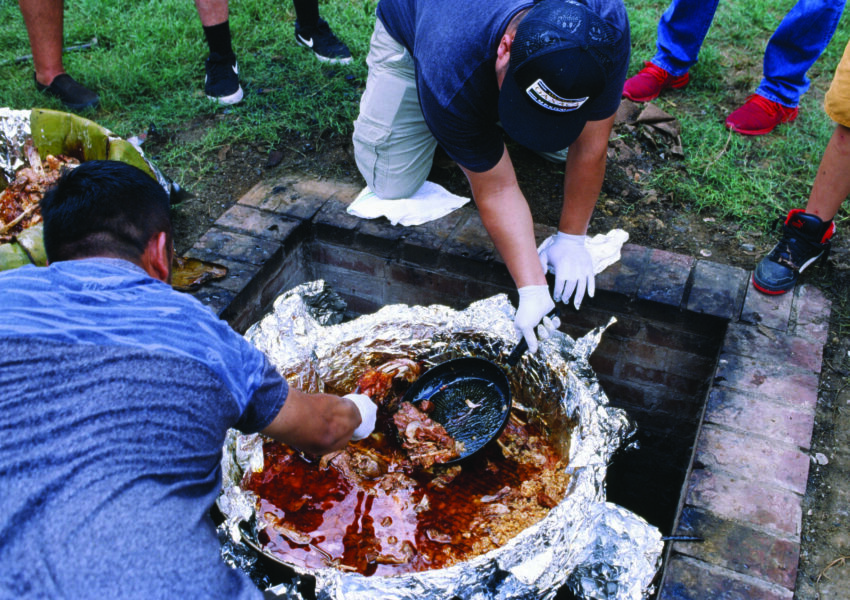I Call Dibi! A chef’s beloved West African barbecue traditions
by Pierre Thiam
Photos by Evan Sung
![]()
The cultures and rituals of barbecue look different in West Africa. In Wolof, the local language of my native country of Senegal, the concept called teranga translates as hospitality. That perfectly describes the soul of West African food culture.
I named my restaurant Teranga because I wanted to create a hospitable space amidst the hustle and bustle of New York City. The spirit of teranga and the concept of gathering for barbecue are very closely related. When I was growing up in Senegal, most home cooks worked with a tool called the fourneau, a French word for a small charcoal burner. It consists of two pieces of metal, one on top of the other. The upper piece is a wok-like structure with an opening on the bottom covered by a metal grate that holds the burning charcoal and allows air to circulate. The lower piece connects the base to a cylindrical chimney that facilitates fanning the fire and collecting ashes. Place a pot or pan directly on the hot coals and a fourneau acts like a stove. Plop a metal rack on top and it becomes a grill. In Senegal, almost every household keeps a fourneau in their backyard and uses it daily.
Back home in Dakar, we burned wood charcoal when cooking on the fourneau to infuse meats with smoky fragrance and flavor. My mother would throw all types of meat on our fourneau to feed us kids, and any friends or relatives who happened to be at our house. She’d cook lamb, guinea hens, chicken, or whole thiof (white grouper). On the side, she would serve either plain white rice and a citrusy sauce, or fried plantains and a salad.
In Senegal, we celebrate a Muslim holiday called Eid Al-Adha (or Tabaski, in Wolof), also referred to as “The Feast of the Lamb.” Senegal is a 95 percent Muslim country, so on this day, every street in the country is filled with fragrant smells of lamb grilling on fourneau burners. Before cooking, choice cuts of meat are given to Christian families by their Muslim neighbors as an offering of peace. This gesture is reciprocated on Good Friday, when Christians offer a sweet porridge made of baobab fruit, peanut butter, and millet to their Muslim neighbors and friends.

In West Africa, barbecue is also considered street food. One of my favorite dishes—found on street corners all throughout Dakar and other great West African cities like Lagos, Nigeria, and Abidjan, Ivory Coast—is suya. Suya is prepared by rubbing thinly sliced pieces of meat (usually lamb or beef) with kankankan, arranging them on platters, and letting them marinate at room temperature to allow the meat to tenderize and soak in the spice mixture. The cook works a large grill rack placed over a burning charcoal brazier. To bring the meat to perfection, the sweaty cook deftly flips the marinated lamb with a long pair of tongs. Occasionally, he dips a paintbrush into a recycled tomato can of kankankan-infused vegetable oil and brushes the glaze over the flaming meat. The kitchen scene is almost identical in every suya joint in West Africa.
Vendors serve suya on skewers or directly on a plate, accompanied with thin slices of raw onions and more kankankan powder to serve as a dry dip. In Senegal, Suya can also be sandwiched in baguette bread, a heritage of our French colonial past. A small suya skewer generally costs around 50 West African CFA francs, or 10 U.S. cents.
Suya joints are usually dark and smoky shacks, with rustic long wooden benches surrounding wooden tables covered in vinyl. In older joints, the walls have darkened over time from the smoke of poorly ventilated kitchens. Few suya joints have menus. Offerings usually include grilled suya and either the local beer, La Gazelle, or fresh juices made of ginger or hibiscus.

One of my favorite suya places is Glover Court Suya in Lagos, Nigeria. A popular outdoor spot in a breezy, open-air space surrounded by eucalyptus trees, Glover Court Suya is a feast for the senses. There, dozens of suya vendors gather each day. Each vendor has a table and several large, charcoal-fueled grills. And as the workday comes to a close, hundreds of Lagosians of all walks of life line up at their favorite grills. Some are still in their office suits, others wear the latest fashions from local or international designers, and some women even don colorful wax-fabric headwraps to match their traditional dresses. Wafts of smoked charcoal and grilled meats fill the air. The mood is happy as patrons celebrate the end of another work day, talking and laughing while dipping their grilled meats in the dry kankankan dip.
In Dakar, I like to watch the solo vendors who sell suya from motorless rickshaw carts retrofitted with fourneaux. I think of meals past and plan my next suya, hot from the grill.
Suya is sometimes called “dibi Hausa” in Senegal. The word dibi refers to barbecue in Wolof, Senegal’s native tongue. The Hausa people are the largest ethnic group in Sub-Saharan Africa, and the creators of suya. Mainly located in northern Nigeria, Hausas can be found in a great number of African countries, which explains why the dish is popular in so many different parts of West Africa.
But don’t be confused: Suya (or dibi Hausa) is distinct from dibi, another style of West African barbecue. Dibi is also cooked on a grill or in a wood-burning oven, but the meat is not thinly sliced like suya and it is not marinated with kankankan. Dibiterie is the name given to the barbecue joints where dibi is served. Dibiteries are the places where people meet after going to the clubs, or just to hang out with friends. Unlike suya joints, dibiterie menus offer a wider variety of meats and cuts, including beef, chicken, sheep, or lamb. They might serve chunky pieces of beef ribs, chicken legs, or other bone-in meat, as well as offal—heart, gizzards, liver, or tripe. The latter are commonly called lakhass, which translates as “knots” in Wolof, because of the way the tripes are tied up, giving it the appearance of a tangled rope.

At a dibiterie, cooks usually work large earthen ovens, fueled with burning logs. Depending on the cut of meat, the cook places the meat closer or farther from the wood fire. A popular technique in dibiterie is when the meat is cooked en papillote: wrapped in kraft paper, seasoned with salt, lots of freshly crushed black pepper, garlic, mustard, and thyme, topped with thick onion slices. The meat cooks slowly in its envelope, in the back of the oven, where the heat is less intense. Still wrapped in the kraft paper which has puffed from the steam, the meat arrives at the table. Unwrapping the paper releases an aroma of seasoned cooked meat and onions—and a meltingly tender and flavorful dibi.
In dibiteries, one can even preorder a whole lamb, including the head, which is considered a delicacy. Cooking a whole lamb dibi is known as mechoui. It’s a style we borrowed from our northern neighbors in Mauritania. Mauritania is also known for camel meat barbecue, served on special occasions, throughout northern Africa and the Middle East. Dibi is traditionally served with simple sides like French fries, fried plantain, or a lettuce and tomato salad. At dibiteries, food is ordered by weight in two sizes: libar (half a kilo) or kilo. To avoid the long wait, people place their orders early in the day, because the meat can take up to an hour to cook.
One of my favorite dibiteries is a place in Dakar called Bantyii. It is located downtown, just a few blocks from the popular Sandaga market. There is no name at the door, and the unassuming building where it is located seems to be crumbling. Inside Bantyii, the scene is surreal. The place is dark and smoky, with low tables and benches surrounding a dozen grills. Like Grover Place Suya in Lagos, Bantyii is run by a collection of independent vendors from different West African countries: Mali, Guinea, Niger, Nigeria and, of course, Senegal.

The decor of a dibiterie resembles that of a suya place, except that there are condiments on each table. Usually, it’s a jar of Dijon mustard, a bottle of Arome Maggi aromatic seasoning, and hot pepper sauce. Dibiteries also offer utensils, but their use is optional. In Senegal, many believe that food tastes better when eaten by hand.
Though beef, lamb, and goat are most commonly used for dibi, pork dibi can also be found in the southern Senegalese region of Casamance, where there is a sizable Christian population. I once ate a gamey dibi prepared with antelope meat that the dibiterie owner had hunted.
Dibi is also synonymous with nightlife in Dakar. The atmosphere can get raucous when patrons begin discussing politics, soccer, or wrestling. In Senegal, wrestling is even more popular than soccer, and the wrestling champions are celebrities. Unlike Olympic-style wrestling, blows with the hand are allowed in Senegalese wrestling. Fights take place in stadiums packed with cheering fans.
In West African kitchens, the physical act of barbecuing—roasting or broiling food on a fourneau, oven over wood charcoal—is quite commonplace. And the culture of barbecuing—coming together around a meal prepared for multiple people to celebrate life—is also deeply ingrained.

As a West African chef living in America, it’s an important part of my purpose to share the food and cooking techniques inherited from my ancestors. Beef suya is a popular snack at my New York restaurant. Here, at my home in El Cerrito Hills, California, I don’t have a fourneau, but I do have a Weber grill, and I always use it to recreate the same smoky, slow-cooked flavors of dibi. Come summer, in the spirit of teranga, I often invite friends over for dibi in my Californian backyard. My secret for entertaining is to keep things simple. That’s why I also use my grill to prepare the vegetable sides. I use vegetables from the local farmers’ market. Asparagus, mushrooms, bell peppers, zucchinis and thick slices of red onions, tossed together with a little oil and then grilled until soft and charred, but still firm to the bite. I serve the grilled vegetables as a warm salad, dressed with a simple lemon-and-olive-oil vinaigrette and garnished with some fresh basil. The atmosphere at my backyard dibi party is always joyous and sometimes loud, just like my favorite dibiterie or suya joints in Lagos and Dakar.
Pierre Thiam is a chef, restaurateur, cookbook author, and social entrepreneur. He is the president and cofounder of Yolélé, an African food distribution company.
SIGN UP FOR THE DIGEST TO RECEIVE GRAVY IN YOUR INBOX.




